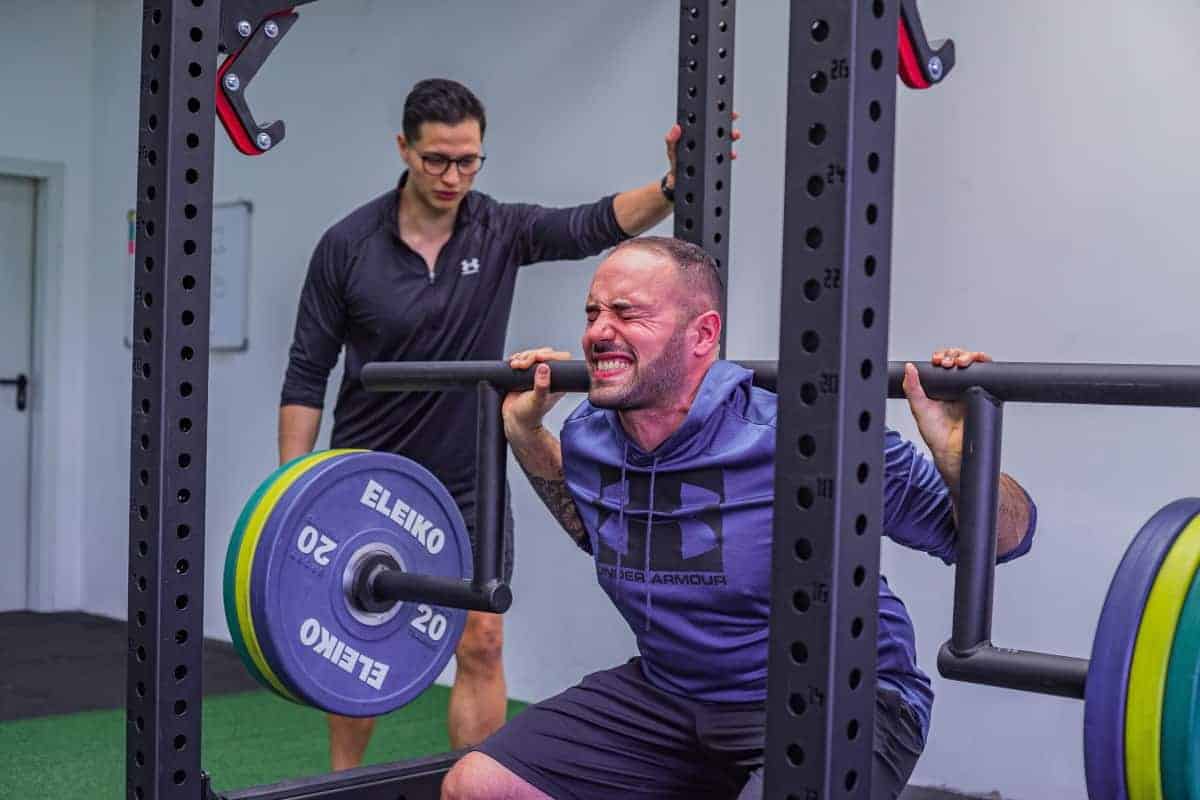In this article, we will show you how to calculate 1RM to know your maximum strength.
What is and what is the purpose of a one-repetition maximum test (1rm)?
The one-repetition maximum is a parameter that measures and records the maximum load that a muscle or muscle group can lift in a single repetition. It is commonly known as 1 Repetition Maximum (1rm) and is the most used parameter in different sports disciplines, mainly strength and/or power.
This test is one of many physical tests that can be performed to evaluate the physical condition of a subject. It is mainly used to measure maximum strength and program certain training variables based on the test results.
Although traditionally used in all sports disciplines involving strength, nowadays there is some controversy in the use of 1rm in certain disciplines and/or sports moments.
Who is it aimed at and how to do a 1 rm test?
According to current scientific evidence, the test to calculate 1 rm is safe and reliable in the following population groups:
- Children aged 6 to 12 years (1)
- Adolescents aged 15-17 years (2)
- Healthy and untrained adults aged 18-36 years (3,4)
- Untrained middle-aged individuals aged 50-52 years (5)
- Postmenopausal women aged 54-60 years (6)
- Cardiac patients (7)
- People over 75 years old (8)
It can be concluded that the test to calculate 1 rm is safe and reliable for all population groups.
However, it is recommended to follow a series of tips and steps to carry out this type of test, especially with untrained people:
- Conduct one or more familiarization sessions with the machine or test material (barbell, dumbbell, etc.)
- Have the presence of several people: a qualified person to guide the test and help when necessary and another to encourage the subject to make a maximum effort.
- Perform a prior warm-up to prevent possible injuries.
- Respect the rest periods set by the professional.
Ways to calculate 1 rm
There are 2 ways to calculate 1 rm: directly by doing the 1rm test or through an estimation. Let’s see what they consist of as well as their advantages and disadvantages:
Direct method: 1 rm test
It consists of carrying out the 1 rm test and is the most direct and precise way to calculate 1 rm.
Advantages
- Reliability
- Precision
Disadvantages
- Risk of injury due to maximum loads
- Need for familiarization sessions for untrained people
Protocol for performing the 1 rm test
As mentioned earlier, it is important that the tested person has completed the familiarization sessions of the exercise. The protocol proposed below is the most used in scientific research and consists of the following phases:
- The participant will choose the load that allows them to perform between 6 and 10 repetitions.
- Rest between 1 and 5 minutes as determined by the evaluator.
- The participant will choose a weight, based on the effort made in the first set, that allows them to perform 3 repetitions.
- Rest between 1 and 5 minutes as determined by the evaluator.
- The participant increases the weight until achieving their maximum repetition.
Considerations around performing the test
The following aspects must be taken into account when carrying out a test of this type:
- Range of motion: for the repetition to be valid, the range of motion must be the same as in the rest of the repetitions. The examiner will ensure that the range of motion is correct for it to be valid.
- Injuries: it is very important that participants do not have any type of injury. If they have recently suffered one, the doctor must consent to the performance of this test.
- Time of test performance: circadian rhythms significantly influence this type of test, being most recommended to carry them out in the afternoon or evening rather than in the morning (9).
- Effort character: for the result to be reliable, participants must try to make a maximum effort.
Indirect method: estimation
Another way to calculate 1 rm is through an estimation. Traditionally, it is done with mathematical formulas, although an accelerometer can also be used for these estimations. This method is a modified 1 rm test, as the test ends before reaching the 1rm, which will be calculated through the formula.
Advantages
- The subject does not bear the high loads of the test
- The estimation is reliable
- Time-saving
- No equipment required
Disadvantages
- Margin of error in the estimation
Calculate 1 rm through formulas
There are many authors who have validated their formulas to calculate the 1 rm. According to different studies, those with the least margin of error and greatest relative precision compared to other formulas are those of Epley, Mayhew, and Wathan (11):
Epley formula
Epley in 1985 created the following formula for calculating the maximum repetition.
1RM= Weight (kg)x (1+0.0333 x reps)”
Mayhew formula
Mayhew et al. created the following formula to calculate 1 rm:
1 RM= (100 × Weight) / [52.2 + (41.9 × e( -0.055 × repetitions ))]
Wathan formula
Finally, Wathan in 1994 validated the following formula to calculate the 1 rm:
1 rm= ( 100 × Weight) / [48.8 + ( 53.8 × e(-0.075 × repetitions ))]
Calculate 1 rm through an accelerometer
One of the most reliable ways to calculate 1 rm is through the use of an accelerometer that measures the speed at which the load moves in a movement and calculates 1 rm. An accelerometer is an instrument that measures accelerations.
The main advantage is that it is a very precise instrument, although the disadvantage is that these types of devices are not very economical. These types of devices are used in the so-called velocity-based training.
A 1RM calculator is a tool that helps you estimate your maximum strength in an exercise based on the weight you can lift and the number of repetitions you can perform with that weight.
What method is more recommended to calculate 1 rm?
This question was asked by some researchers when they studied the reliability of different methods (a 1 rm test, estimation formulas to calculate 1RM, general force-velocity curve and individual force-velocity curve) to calculate 1 rm in a horizontal pull with a bar.
It was concluded that all estimation methods to calculate 1 rm were valid and precise, although the individual force-velocity curve with an accelerometer was the method that came closest to the real 1rm (12).
Conclusions
The 1 rm is a parameter that assesses the maximum strength of a subject and allows programming different variables of their training.
Performing a 1 rm test is safe and reliable if the evaluated subject is previously familiarized and a series of considerations are taken into account.
Many researchers developed valid and reliable mathematical formulas to calculate 1 rm to avoid the risks associated with the test.
The estimation of 1 rm through accelerometers is the most accurate way to calculate 1 rm indirectly.
Although it offers an approximation, using it properly helps you plan your training sessions, track progress, and achieve your goals more accurately. Make sure to perform the test safely and consider using it in combination with professional guidance to get the best results.
Bibliographic references
- Faigenbaum, A. D., Milliken, L. A., & Westcott, W. L. (2003). Maximal strength testing in healthy children. Journal of strength and conditioning research, 17(1), 162–166. https://doi.org/10.1519/1533-4287(2003)017<0162:mstihc>2.0.co;2
- Faigenbaum, A. D., McFarland, J. E., Herman, R. E., Naclerio, F., Ratamess, N. A., Kang, J., & Myer, G. D. (2012). Reliability of the one-repetition-maximum power clean test in adolescent athletes. Journal of strength and conditioning research, 26(2), 432–437. https://doi.org/10.1519/JSC.0b013e318220db2c
- English, K. L., Loehr, J. A., Laughlin, M. A., Lee, S. M., & Hagan, R. D. (2008). Reliability of strength testing using the advanced resistive exercise device and free weights. NASA Technical Paper, 214728.
- Bezerra, E. S., Simão, R., Fleck, S. J., Paz, G., Maia, M., Costa, P. B., … & Serrão, J. C. (2013). Electromyographic activity of lower body muscles during the deadlift and still-legged deadlift. Journal of Exercise Physiology Online, 16(3), 30-39.
- Levinger, I., Goodman, C., Hare, D. L., Jerums, G., Toia, D., & Selig, S. (2009). The reliability of the 1RM strength test for untrained middle-aged individuals. Journal of science and medicine in sport, 12(2), 310–316. https://doi.org/10.1016/j.jsams.2007.10.007
- Kemmler, W. K., Lauber, D., Wassermann, A., & Mayhew, J. L. (2006). Predicting maximal strength in trained postmenopausal woman. Journal of strength and conditioning research, 20(4), 838–842. https://doi.org/10.1519/R-18905.1 Link
- Ghilarducci, L. E., Holly, R. G., & Amsterdam, E. A. (1989). Effects of high resistance training in coronary artery disease. The American journal of cardiology, 64(14), 866–870. https://doi.org/10.1016/0002-9149(89)90833-3 Link
- Rydwik, E., Karlsson, C., Frändin, K., & Akner, G. (2007). Muscle strength testing with one repetition maximum in the arm/shoulder for people aged 75 + – test-retest reliability. Clinical rehabilitation, 21(3), 258–265. https://doi.org/10.1177/0269215506072088 Link
- Teo, W., Newton, M. J., & McGuigan, M. R. (2011). Circadian rhythms in exercise performance: implications for hormonal and muscular adaptation. Journal of sports science & medicine, 10(4), 600–606.
- Walker O. (2016). 1 rm testing. Retrieved from: scienceforsport.com
- Wood, T. M., Maddalozzo, G. F., & Harter, R. A. (2009). Accuracy of seven equations for predicting 1-RM performance of apparently healthy, sedentary older adults. Measurement in Physical Education and Exercise Science, 6(2), 67–94
- García-Ramos, A., Barboza-González, P., Ulloa-Díaz, D., Rodriguez-Perea, A., Martinez-Garcia, D., Guede-Rojas, F., … & Weakley, J. (2019). Reliability and validity of different methods of estimating the one-repetition maximum during the free-weight prone bench pull exercise. Journal of sports sciences, 37(19), 2205-2212.



